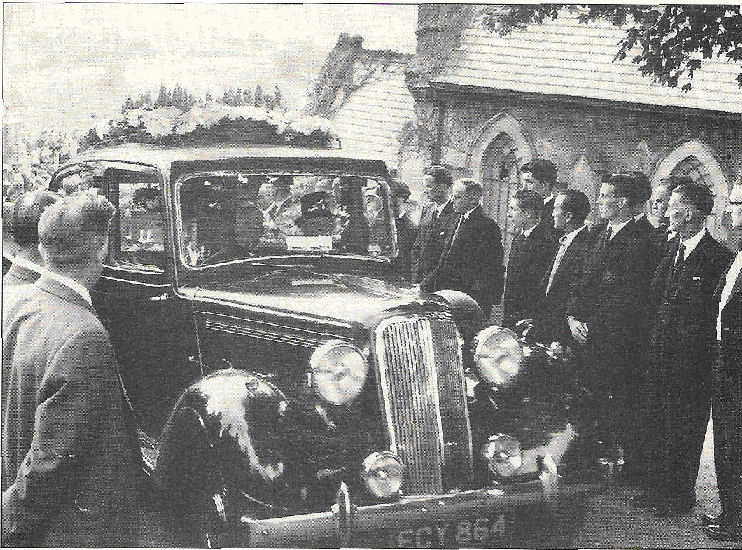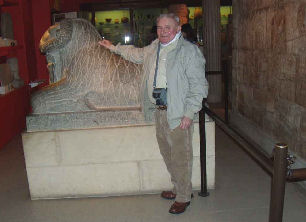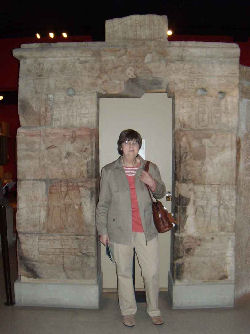100 Club
April 2010 – to be drawn at the May lecture.
Fund raising April - £469.
We were pleased to have been awarded a grant for £3000 from the Voluntary Services sector of Blaenau Gwent CBC- £400 has been used to buy a new computer and the rest will go towards the running costs of the Museum. A big thank you!
Diary Dates
Wednesday 5 th May 2010 – Ralph Robinson Memorial Lecture Owain Glyndwr by Chris Barber
Saturday 8 th May 2010 – Cake Decorating –Coffee Morning 50p
Lectures start at 7.00pm in the Metropole Theatre, with teas and a chat downstairs in the Museum afterwards. Entry is £2 and the public are most welcome.
Six Bells Pit Disaster
The 50 th anniversary of this tragic event is fast approaching. The commemorations include the erection of a memorial to those who lost their lives and as our Museum is part of the local community we want to play our part in remembering this sad event. Don Bearcroft hoped to have a board with people’s personal recollections but the response so far has been quite limited. It is an event which is remembered by so many of us; please come forward with your memories.
On a related note, the Committee responsible for organising the memorial have been trying to trace the relatives of those who died, but there are still some gaps. Can you help? Do you know anyone related to the following people:
Robert Brown, Cromwell Street, Abertillery
John Woosman, Bournville
Albert Gardner, Mount Pleasant, Pant y Pwdyn
Vernon Griffiths (Father) Brynithel
Clive Griffiths (Son) Brynithel
Idris Jones, Windsor Road, Six Bells
John Jones, Cwm Cottage Road, Six Bells
George Luffman, Maes Hafod, Blaina
Colin Malcolm Donald Morgan, Park View, Abertillery.
If you can help please contact Don Bearcroft at the Museum.
Poet’s Corner
WATCHING
I sometimes feel you near
watching what I do,
But I cannot disapprove,
for you still influence me.
to follow the right path.
Feeling you are real,
I turn expecting to see you,
But you are from my past
intangible, out of reach forever.
Once you held my hand.
Took me on your knee,
hugged, consoled, loved me,
Infused me with life spirit,
until vanishing left a void.
Your image will not age,
stored with good memories,
Though I walk with others,
I sometimes feel you near,
watching whatever I do.
Gordon Rowlands, August 2006
Myths and Legends
The story of the Hellebore plant
It is said that this plant lined the side of the road where Jesus walked to his crucifixion. The plants were so overcome with guilt and remorse that they hung their heads in shame. A short while later (supposedly three days later when the resurrection happened) they proudly rose their heads in praise and jubilation.
I have this plant in my garden, and yes their heads hang down but to date I have not seen the heads rise up. But Easter was early this year wasn't it?
Anyway it’s rather a nice story don't you think?
Enid Dean
Local Voices
‘Personal Connections with Six Bells’
In the early 1930s living in Railway Street, I was a pupil at Ty’r Graig School, Aberbeeg for juniors up to the age of 11 years. During these years it was common to walk in groups to the Lido built by Six Bells miners. Passing by the often silent pithead on the other side of the valley, little did I foresee my future connection with the pit.
Men from Llanhilleth working at Six Bells Colliery were envied for the large ‘blocks’ -firewood they were allowed to carry home free, whilst Llanhilleth miners were penalised if caught doing so.
In 1953 after a period in Glyntillery wet pit as a Deputy, I was seconded to Area 6 Safety Department. Apart from safety duties at most pits in the area, I was tasked with setting up a Universal Emergency Organisation for dealing with potential disasters in Area 6. At Six Bells colliery office, metal discs and books of directives were installed in accordance with this Emergency Organisation Control.
In another category as a member of Area 6 Mechanisation Team I visited Six Bells to see the installation of aluminium supports, later withdrawn for safety reasons. I also visited Vivian Colliery to meet the Manager Tom Wallace and physically install steel roof supports from Six Bells.
In 1960 as Manager of Waunlwyd Colliery and Chairman of Nr1 Group, British Association of Colliery Management of South Wales, I was at Brynithel Cemetery for the interment of bodies from the Six Bells explosion with two colleagues.

During a break in the interments the three of us visited my sister Betty Othen and her husband, publicans at the Carpenters Arms (St Illtyds) near Brynithel for tea & sandwiches.
Arthur Lewis OBE
Mr Macnamara – Myth or reality?
Most parts of Britain are subject to folklore and myth, abounding with stories based originally on fact but embellished in the telling and retelling until it is difficult to distinguish truth from embroidery. The Black Mountains area of the Brecon Beacons National Park contains remote hills and vales which are a typical setting for such tales, one of which relates to Mr Macnamara.
John Macnamara is reported to have been a member of the notorious Hell Fire Club and a regency period gambler who won Llangoed castle and Estate, north of Talgarth, in a high stakes gambling match. Llangoed, never a castle, was a large country house (now a hotel) near Llyswen and was the home of the Williams family whose coat of arms gave its name to the village of Three Cocks. The Llangoed estate of some 54,000 acres included large areas of Grwyne Fechan and Fawr valleys, the latter being the location of the Abertillery waterworks. The loser believed it unlikely that a high society gambler would settle long in this remote part of Wales and so he extracted a promise he would “sell back the estate when no longer on the land”. Contrary to prediction, Macnamara and his wife proceeded to establish themselves at Llangoed Castle. It is also said that John Macnamara became so settled that he built a large house called The Hermitage in the remote upper Grwyne Fechan valley and installed a mistress. This section of the valley was not accessible by coach so he arranged to have a high level road built for his use, an indication no doubt of the lady’s fascination and attraction.
When the high living Macnamara died in 1818 his widow was put in a difficult position when pressed to honour the promise made at the gambling match. Mrs Macnamara was by now quite settled at Llangoed Castle and believed the land was rightfully hers, so she arranged for her dead husband’s body to be placed in a tomb deliberately built above ground. In this way John Macnamara would remain ‘on the land’ forever, his promise unbroken..
So much for the story but is it possible to establish any facts relating to the alleged events? A number of writers have refereed to aspects of the tale such as H V Massingham in “The Southern Marches” who repeats the story but is unable to explain how a coach could travel on such a “road”. While “the road” does not appear on current maps there is evidence of it on the ground and it seems to follow a line shown in Professor Rees’ “Fourteenth Century Welsh roads”, passing over land owned by John Macnamara.
The Hermitage, now in ruins, is described in “Hills and Vales of the Black Mountains” by R Baker Gabb, as a “four square Georgian style building with timber panelling and extensive cellars”. Not what would be expected in the upper reaches of a remote valley! Later writers like Rob Adams in “Brycheiniog” in 2008 describe Sir Edward Williams the owner of Llangoed Castle as being heavily in debt in 1791 and needing to move to Bristol “for health reasons” to avoid creditors. The estate was subject to mortgages and trusts and the sale may have been brought on by losses at cards.
John Macnamara described himself as having spent his early days “whoring, drinking, gambling and duelling” and there is general belief that the events described actually happened. On the death of Mrs Macnamara Llangoed Castle, the estate and its road, and The Hermitage were inherited by John Macnamara’s son. In 1847 he sold the property to Sir Joseph Bailey of Glanusk whose wealth largely came from Nantyglo Ironworks but John Macnamara would remain on its land for Eternity.
Laurence Hale
Nevill Hall
The original Nevill Hall, located behind the main hospital building, was built in the 1860s as a country house for James Charles Hill, of Blaenavon Ironworks, and was known as ‘The Brooks’. He had purchased the existing property in 1860, followed by demolition and rebuilding. It was then bought in 1890 by the Marquess of Abergavenny and renamed Nevill Hall. It had further owners who used it as a house until 1920 when it became a hospital. After the building in the 1970s of the ‘new’ hospital now in place, the old Nevill Hall became a conference and training centre for the health authority. The building has been listed for its special interest as a substantial well-preserved former country house with historic connections first with a prominent local industrialist and later with the Marquess of Abergavenny.
Book Corner
A Place of Meadows and Tall Trees by Clare Dudman , price £7.99
Impoverished and oppressed, they had been promised paradise on earth but instead the settlers found a cold South American desert where nothing could survive except nomadic Indians, possibly intent on massacring them. Silas James fears he has been tricked into sacrificing everything for another man’s dream but a new culture gradually takes root and he benefits from the guidance of the local Indian shaman. This story evokes the trials facing the first Welsh Patagonian colonists.
MUSEUM MATTERS
Ashmoleam museum
The trip to Oxford had something for everyone, mine and Peggy's interest in Egyptology our first stop was Lawrence of Arabia's costume then on to the Egyptian Galleries and the Griffith Gallery which houses one of the world's finest collections of Nubian antiquities, derived from excavations conducted in this century by Oxford University and other bodies. The Oxford Excavations were largely financed by F.LI. Griffith. Between the years 1907 and 1913, he investigated the sites of Faras, Kawa and Sanam.
 Interest in the history and archaeology of Nubia was fostered by the building of the Aswan Dam (1898—1902) and the High Dam (1960—1971), which resulted in the flooding of much of Lower Nubia. Major rescue campaigns of survey and excavation were conducted in 1907—1908, 1929—1931 and from 1959 onwards. Pioneers in the field of Nubian studies were the American archaeologist George A. Reisner and the first Professor of Egyptology at Oxford, F.l. Griffith.
Interest in the history and archaeology of Nubia was fostered by the building of the Aswan Dam (1898—1902) and the High Dam (1960—1971), which resulted in the flooding of much of Lower Nubia. Major rescue campaigns of survey and excavation were conducted in 1907—1908, 1929—1931 and from 1959 onwards. Pioneers in the field of Nubian studies were the American archaeologist George A. Reisner and the first Professor of Egyptology at Oxford, F.l. Griffith.
To the Egyptians, Nubia was known as the " Land of Kush". It had its own languages and cultures, but also a long history of involvement with Egypt. From the Old Kingdom until the Roman period, Nubia's cattle, goldmines and mineral resources were exploited by the rulers of Egypt, who were also keen to secure the African trade routes by which ivory, ebony, incense, oils, skins, feathers, copper and, most importantly gold reached Egypt and the Mediterranean world via Nubia.
NUBIA is the southern stretch of the Nile Valley from the First to the Sixth Cataracts, together with its border regions. In modern terms the southernmost part of Egypt, and Sudan. The area between the First and Second Cataracts is generally known as Lower Nubia (corresponding to the ancient Egyptian (Wawat ), the area between the Second and Sixth Cataracts as Upper Nubia (Rush ). . Egypt therefore took a keen interest in its southern neighb our, conquering it at various periods.

Nubian influences on Predynastic Egyptian culture can be traced in styles of pottery and in shared traits such as cattle burials. Towards the end of the Predynastic Period , centres of political power developed in Lower Nubia , notably at Seyala and Qustul. Their advanced culture is termed the A-Group. However, as Egypt moved towards a unified state, its rulers began to impose their authority on Nubia by military means. Campaigns are suggested by inscriptions at Gebel Sheikh Suleiman in the Second Cataract region, and by references on 1 st Dynasty labels to Ta-Sety ('land of the bowmen'), the earliest Egyptian name for Nubia. At the same time, the A-Group disappears from the archaeo logical record, presumably extinguished by repeated Egyptian attacks.
Nubian soldiers played an important role in the Theban armies during the civil war of the First Intermediate period and Nubian Archers renowned for their skill served as mercenaries down the ages.
However, following the reuni fication of Egypt under Mentuhotep II, the Egyptian attitude to its southern neighbour changed markedly. The Middle Kingdom is characterised by the con struction of a series of fortresses, within signaling dis tance of one another, throughout Lower Nubia, and the fortification of the border at Semna . The fortifications had defenses far in front of their time. equal to the Medieval castles of Europe in the middle ages
The background seems to have been an increasing threat from the Kingdom of Kush , centred at Kerma in Upper Nubia .
Following the expulsion of the Hyksos, the i8th Dynasty kings lost no time in conquering Kush and formally annexing Nubia as far as the Fourth Cataract (Gebel Barkal) . New towns and temples were founded along Egyptian lines; Nubia was governed by a Viceroy of Kush , appointed by the king;

Following the collapse of the New Kingdom state, local rulers regained control and began to expand their authority. In a reversal of the usual process, the descendants of the Kushite kings conquered Egypt and ruled as the 25th Dynasty. The most powerful of these Nubian kings was Taharqa (690—664 BC) who ruled Nubia and all Egypt.
Their home town of Napata was adorned with monuments. The rulers themselves adopted Egyptian burial customs ,  building pyramid C- style tombs at el-Kurru, and later, following their retreat back to their Nubian heartland, at NuRi and Meroe. In the Later Period and following eras, as Egypt was con quered by successive foreign powers, Nubia retained a vibrant indigenous tradition, represented by the Meroi'tic and X-Group
building pyramid C- style tombs at el-Kurru, and later, following their retreat back to their Nubian heartland, at NuRi and Meroe. In the Later Period and following eras, as Egypt was con quered by successive foreign powers, Nubia retained a vibrant indigenous tradition, represented by the Meroi'tic and X-Group
(c. ad 350-700) cultures.
Don Bearcroft
